第一性原理- DFT理论 ppt课件
铁电体的第一性原理研究进展PPT课件
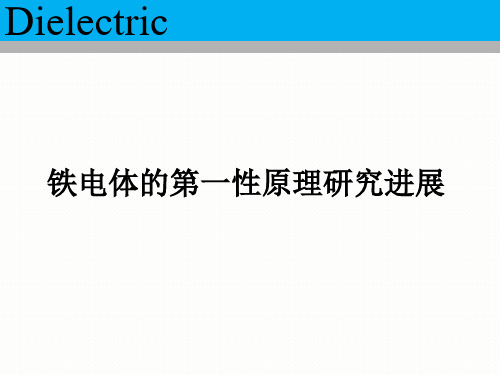
国内外研究现状
Cohen首次采用第一性原理计算BaTIO3和PbTIO3的电子密度,表明Ti的3d电子 和O的2P电子波函数有显著的交叠,而且铁电情况下的交叠比顺电情况更强, 进而得出结论:对于ABO3结构的钙钦矿型铁电体,B离子的d电子与氧离子的 2p电子之间存在比较强的轨道杂化,这种轨道杂化抑制了短程排斥力从而使 铁电性得以稳定。
4.集成铁电体的研究(铁电薄膜与半导体集成):
由于铁电存储器的诸多优点,近几年来人们对铁电薄膜与半导体集成投入了大量的研究。 铁电薄膜的极化具备两个不同的稳定状态(剩余极化强度士Pr),可分别作为信息存储的“0‘’ 和,‘l”代码。早在50年代人们就开始作了这方面的研究。当时存在的问题主要为:块材要求 电压很高,不能满足应用的要求;电滞回线的矩形度差,易发生读写错误;疲劳特性很差。80年 代以来,由于铁电薄膜制备技术的改进,新的铁电材料及电极材料的出现,铁电存储器又重新 活跃起来。
2.Gaussian98程序包。Gaussian98程序包中包含许多种计算方法,包括半经验及第一性 原理计算方法等。它是一个功能全面的计算程序包。它的主要处理对象是有机大分子体系, 计算时主要对单一大分子体系的各种性质进行计算。能给出有机分子的振动模式及反应过 程的信息。它的缺点是对含有重金属原子体系的计算几乎无法进行。
研究热点
尺寸效应和表面界面效应
金属或半导体电极间的铁电薄膜 铁电聚合物和复合材料的研究
写在最后
成功的基础在于好的学习习惯
The foundation of success lies in good habits
17
谢谢聆听
·学习就是为了达到一定目的而努力去干, 是为一个目标去 战胜各种困难的过程,这个过程会充满压力、痛苦和挫折
第一性原理理论介绍
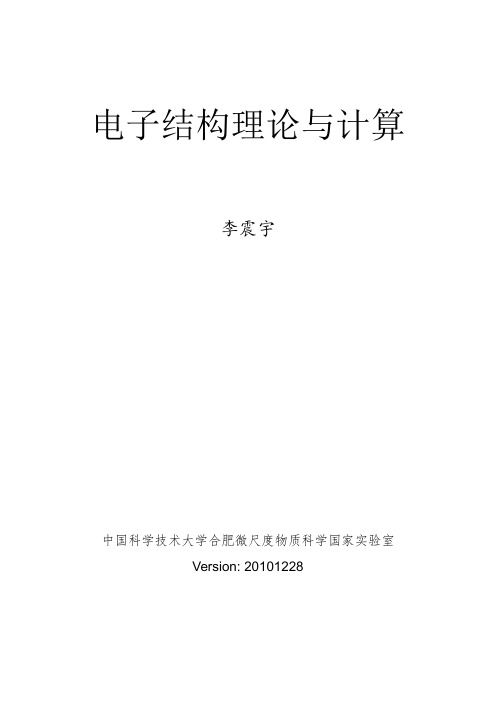
h2
2 2 2 v r2 2m
假设 E a b , a 1 b 2 是两电子体系本征方程的解,则
ˆ 1 2 2 1 1 2 P 12 a b a b a b
2 1 2 2
N 1 N 2
1, 2 N
1 N
2 N
N N
上式的反对称性是很明显的, 因为任意两个粒子坐标的互换, 相当于行列式中相应的两列元 素的互换, 将改变行列式的符号。 同时, 若有两个或两个以上单粒子波函数相等, 则 SD 0 , 意味着这样的状态是不存在的,这就是 Pauli 不相容原理。
1
前言
理念:1. 实用:介绍计算参数的意义和选择策略;2. 简洁:注重物 理概念,不过分纠缠于细节。
参考资料: [1] Richard M Martin, Electronic Structure: Basic Theory and Practical Methods. Cambridge University Press, Cambridge, 2004. [2] Christopher J Cramer, Essentials of Computational Chemistry: Theories and Models. 2nd Ed. Wiley, England, 2004.
K ab= a 1 b 1
分别代表电子间的库仑排斥能和交换能。交换能 Kab 是采用 Slater 行列式以后比 HP 多出来 的同自旋电子间的一种相互作用。 Roothann 提出可以基组表象来建立了 HF‐SCF 的矩阵代数。 如果将分子轨道写成一些基函数的线性组合, 则单电子哈密顿量在这组基组下可以表示为一 个 矩 阵 。 常用 的 基 组 有原 子 轨 道 和平 面 波 。 对闭 壳 层 体 系, 最 后 可 以得 到 久 期 方程 det(F-ES)=0,其中单电子哈密顿量 f 通常被称为 Fock 算符,其矩阵元为
计算材料学第一性原理密度泛函理论分子动力学ppt课件

波恩-奥本海默近似
因为原子核的质量为电子的1000倍左右,因此其速度比电子慢得多; 那么,可以将电子运动分为两个部分:考虑电子运动时,原子核处于 其瞬时的位置,而考虑核的运动时不考虑电子在空间的具体分布。这 样可以将原子核与电子分离求解。
将上式代人薛定谔方程,电子部分:
哈密顿量:
23
Thomas-Fermi-Dirac近似
非自旋极化系统, 自旋极化系统,
电子气关联能的表达式,
35
交换关联函数, GGA
在L(S)DA的基础上,人们又进一步发展了广义梯度近似(GGA)。GGA 在L(S)DA的基础上,认为交换关联能 不但是电子密度的函数,而且 还是其梯度的函数。其表达式为:
--到此为止,整个过程就只有一次近似,即局域密度近似;那么这个计算 结果的正确与否就决定了LDA(GGA)的合理与否。
交换项
动能项
外场项
库仑项
丢失了很多重要的物理量,如原子的壳层信息
24
Hohenberg-Kohn 定理
定理一: 粒子数密度函数是一个决定系统基 态物理量性质的基本变量。
定理二: 在粒子数不变条件下能量泛函对密 度函数的变分就得到系统基态的能量
25
定理一
定理一: 粒子数密度函数是一个决定系统基 态物理量性质的基本变量。
33
K-S方程求解 (SCF)
求解条件:用来构造有效势的 电荷密度与解Kohn-Sham方程 得来的电荷密度一致。
解Kohn-Sham方程,这一步 计算量最大,里面需要用到许 多技巧,比如平面波展开,赝 势等。
SCF:自洽求解
34
交换关联函数, LDA
交换关联势在意义上是非局域的,我们前面提到这一部分包含两部分 交换相互作用和关联作用(即是有相互作用粒子和无相互作用粒子的
【优秀PPT】第一性原理分子动力学资料

1mR1E,R, 这铁样素建 体立与的奥模氏型体就相是变随及温磁度性变的化从的头模计型算。动力学分2析
第一性原理分子动力学的体系及应用i问题 i i
2
i
I
2 2 第一性原理分子动力学的体系及应用
波函数 和自旋波函数 满足完整约束条件 第一性原理分子动力学的体系及应用
变[5换]得速到度Nosé、Ham、ilton、i ian运、动方和程 ,就可以改变温度。i
2
d3r(r,sz)
sz 2
d3r(r, 2)2 d3r(r, 2)2
1
第一性原理分子动力学的体系及应用
考虑电子自旋的温度相关模型,则可以分析材料磁性质随温度变化的关系,同时也可以分析基于磁致伸性质的材料压磁效应。
定的困难,从而给分子动力学的模拟带来困难。 考虑电子自旋的温度相关模型,则可以分析材料磁性质随温度变化的关系,同时也可以分析基于磁致伸性质的材料压磁效应。
第一性原理分子动力学的体系及应用 对应的Kohn-Sham方程和SDFT方程为
1985年R. Car和M. Parrinello首先提出“分子动力学 和密度泛函理论的统一方法”[
i ( r , t ) E i ( r , t ) k i k k ( r , t )
MIRI RIE
E
与密度泛函理论相似,区别仅在于在势函数中增加了 一项磁相互作用项,因此系统的Hamiltonian算符为
如果忽略压力改变,系统在热力学过程中可以用恒温恒压系综NPT描述。 上述Lagrangean函数构成下列关于参数 、 、
针对不同的材料,构建介观条件下的对势,取决于 铁素体与奥氏体相变及磁性的从头计算动力学分析
如果忽略压力改变,系统在热力学过程中可以用恒温恒压系综NPT描述。
第一性原理计算 ppt课件

ppt课件
9
• 除非i等于j,否则Lagrange乘法因子为0 .
Fi i ij j
•每一个电子都被假设在包括原子核和其他电子的固定区域中运动 •每一个电子方程得到的解都会影响系统中其他电子的解 自洽场假设
解的思路 •得到一个H-F本征方程的试探解,用来计算库仑和交还能。 •解H-F方,给出第二套解。 •一次类推。 •SCF方法逐渐得到对应越来越低能量的单电子的解。直到一点,在这一 点所有的电子的方程不再改变
ij Sij 0
ij
ppt课件
6
• Lagrange乘法因子被写为-ij
E
ij Sij 0
ij
• 多电子系统和单电子系统的最大区别在于存在电子之间的
作用,包括库仑和交换积分
• 找到多电子系统最好的波函数,保留轨道图像
• 找到一个解,当一个电子的轨道变化时由于电子耦合作用 会影响其他自旋轨道上的电子的运动,在上述情况下,这
ppt课件
12
• 完整的轨道,我们要用角度部分乘以径向函数部分
1s (r) 3 / exp(r)
2s (r) 5 / 3 rexp(r)
2 pz (r) 5 / exp(r)cos
ppt课件
13
• Slater给出了一系列的轨道指数的确定原则
Z
n*
Z为原子数,为屏蔽常数,n*为有效的主量子数
n* :
n=1,2,3时取与n相同的值;n=4,5,6s时,取3.7,4.0,4.2
屏蔽常数按下列规则确定 :
把轨道划分如下组: (1s);(2s,2p);(3s,3p);(3d);(4s,4p);(4f);(5s,5p);(5d)
计算材料学ppt课件

• 将多电子问题变为了单电子问题,但是没 有考虑电子的交换反对称性 。为了研究电 子的交换反对称性的影响,采用Slater行 列式来求能量,经过合适的变换,得到了 如式所示方程:
' 2 * ' ' 2 | ( r ) | ( r ) ( r ' ' i ) ' i ' i V ( r ) dr ( r ) dr E ( r ) i ii ' ' ' ' | r r | | r r | i ( i ) i ( i ), ||
• 为了更加准确地描述多电子系统, Hohenberg P和Kohn W提出了两个基本 的定理: • (1) 定理1:不计自旋的全同费密子系统的 基态能量是粒子数密度函数的唯一泛函; • (2) 定理2:能量泛函在粒子数不变条件下 对正确的粒子数密度函数取极小值,并等 于基态能量。
• 定理1的主旨思想是粒子数密度函数是一个 决定系统基态物理性质的基本变量;定理2 的要点是在粒子数不变条件下能量泛函对 密度函数的变分就得到系统基态的能量。 密度泛函理论的理论基础是这两条基本定 理,其基本的思想是原子、分子和固体的 基态物理性质可以用粒子密度函数来表示。
• Kohn- Sham方程中的交换关联势近似为 式
密度为 (r)
E [ ] d V [ ( r )] ( ( r ) [ ( r )]) d ( r )
xc xc xc
xc[(r) :均匀无相互作用电子气的交换-关联密
度,在实际的计算过程中,通常把交换关联密度分成两部分:交换项和关联项。
1 f
4 /3
22 1
1 /3
第一性原理

Ab initio study of the phase diagram of epitaxial BaTiO3Oswaldo Diéguez,*Silvia Tinte,A.Antons,Claudia Bungaro,J.B.Neaton,†Karin M.Rabe,and David Vanderbilt Department of Physics and Astronomy,Rutgers University,Piscataway,New Jersey08854-8019,USA(Received1April2004;published8June2004;corrected5August2004)Using a combination offirst-principles and effective-Hamiltonian approaches,we map out the structure ofBaTiO3under epitaxial constraints applicable to growth on perovskite substrates.We obtain a phase diagramin temperature and misfit strain that is qualitatively different from that reported by Pertsev,Zembilgotov,andTagantsev[Phys.Rev.Lett.80,1988(1998)],who based their results on an empirical thermodynamic potentialwith parametersfitted at temperatures in the vicinity of the bulk phase transitions.In particular,wefind aregion of“r phase”at low temperature where Pertsev et al.have reported an“ac phase.”We expect our resultsto be relevant to thin epitaxialfilms of BaTiO3at low temperatures and experimentally achievable strains.DOI:10.1103/PhysRevB.69.212101PACS number(s):77.55.ϩf,77.80.Bh,77.84.Dy,81.05.ZxThe perovskite oxide barium titanate͑BaTiO3͒is a proto-typical ferroelectric,an insulating solid whose macroscopic polarization can be reoriented by the application of an elec-tricfield.1In the perovskite ferroelectrics,it is well known both experimentally and theoretically that the polarization is also strongly coupled to strain,2and thus that properties such as the ferroelectric transition temperature and polarization magnitude are quite sensitive to external stress.Experimentally,the properties of ferroelectrics in thinfilm form generally differ significantly from those in the bulk.3 While many factors are expected to contribute to these dif-ferences,it has been shown that the properties of perovskite thinfilms are strongly influenced by the magnitude of the epitaxial strain resulting from lattice matching thefilm to the substrate.For example,Yoneda et al.4used molecular-beam epitaxy to grow BaTiO3(lattice constant of4.00Å)on (001)-oriented SrTiO3(lattice constant of 3.91Å);they found that the ferroelectric transition temperature exceeds 600°C,to be compared to the bulk Curie temperature of T C=130°C.Other studies have shown that the amount of strain in BaTiO3/SrTiO3superlattices on SrTiO3substrates strongly influences properties including the observed polar-ization,phase transition temperature,and dielectric constant.5–8In a seminal paper,Pertsev,Zembilgotov and Tagantsev9 introduced the concept of mapping the equilibrium structure of a ferroelectric perovskite material versus temperature and misfit strain,thus producing a“Pertsev phase diagram”(or Pertsev diagram)of the observable epitaxial phases.The ef-fect of epitaxial strain is isolated from other aspects of thin-film geometry by computing the structure of the bulk mate-rial with homogeneous strain tensor constrained to match a given substrate with square surface symmetry.10In addition, short-circuit electrical boundary conditions are imposed, equivalent to ideal electrodes above and beneath thefilm.9 Given the recognized importance of strain in determining the properties of thin-film ferroelectrics,Pertsev diagrams have proven to be of enormous interest to experimentalists seek-ing to interpret the results of experiments on epitaxial thin films and heterostructures.In Ref.9the mapping was carried out with a phenomeno-logical Landau–Devonshire model taken from the literature.This should give excellent results in the temperature/strain regime in which the model parameters werefitted,but will generally be less accurate when extrapolated to other re-gimes.In Fig.1,we compare two Pertsev diagrams for BaTiO3computed using two different sets of Landau–Devonshire parameters,used by Pertsev and co-workers in Refs.9and11,respectively.While both give the same be-havior near the bulk T C and small misfit strains,they predict completely different low-temperature phase behavior.Withfirst-principles methods,it is possible not only to resolve such discrepancies arising in phenomenogical theo-ries,but also to generate a wealth of microscopic information about the structure and properties of epitaxial phases at vari-ous temperatures and substrate lattice constants.In this pa-per,using parameter-free total-energy methods based on den-sity functional theory(DFT),we map out the equilibrium structure of BaTiO3as a function of epitaxial constraints at zero temperature,and then extend the results tofinite tem-perature via an effective-Hamiltonian approach.The Pertsev diagram obtained in this way has a similar global topology as that of Ref.11(but not to the one in Ref.9).This allows us to predict the impact of misfit strain on the magnitudeand FIG.1.Phase diagrams of epitaxial BaTiO3as predicted by the theory of Pertsev et al.(see Ref.9).(a)Using the parameters quoted in Ref.9.(b)Using the parameters quoted in Ref.11.The second-andfirst-order phase transitions are represented by thin and thick lines,respectively.PHYSICAL REVIEW B69,212101(2004)orientation of the polarization and Curie temperature ofBaTiO 3.Our results should thus be of considerable impor-tance for understanding experimental growth of high-quality,coherent epitaxial thin films of BaTiO 3on perovskite sub-strates,as well as more generally illustrating the utility of first-principles Pertsev diagrams.The first-principles DFT calculations are carried out in the Kohn–Sham framework 12using the V ASP software package.13The electron-ion interaction is described by the projector augmented wave method;14semicore electrons are included in the case of Ba ͑5s 25p 66s 2͒and Ti ͑3s 23p 64s 23d 2͒.The calculations employ the Ceperley–Alder 15form of the local-density approximation (LDA )exchange-correlationfunctional,16a 700eV plane-wave cutoff,and a 6ϫ6ϫ6Monkhorst–Pack sampling of the Brillouin zone.17We begin by systematically performing optimizations of the five-atom unit cell of the cubic perovskite structure (space group Pm 3¯m )in the six possible phases considered by Pertsev and co-workers in Ref.9.A description of these phases is given in Table I.Starting from a structure in which the symmetry is established by displacing the Ti and O at-oms,we relax the atomic positions and the out-of-plane cell vector until the value of the Hellmann–Feynman forces and zz ,yz and zx stress tensor components fall below some given thresholds (0.001eV/Åand 0.005eV,respectively ).In Fig.2we present the computed energy for each phase as a function of the misfit strain s =a /a 0−1,where a 0is our DFT lattice constant for free cubic BaTiO 3͑3.955Å͒.For large compressive strains,the lowest energy corresponds to the c phase;for large tensile strains,the aa phase is favored.At a misfit strain of s max ͑c ͒=−6.4ϫ10−3͑a =3.930Å͒,there is a second-order transition from the c phase to the r phase,with the polarization in the r phase continuously rotating away from the z direction as the misfit strain increases.At misfit strain s min ͑aa ͒=6.5ϫ10−3͑a =3.981Å͒,the r phase polarization completes its rotation into the xy plane,resulting in a continuous transition to the aa phase.The minimum energy r phase is at misfit strain of 2.2ϫ10−3͑a =3.964Å͒;lattice matching to the substrate would be optimal at this point.At the misfit strain of the c →r transition,the polar-ization could also begin a continuous rotation into the (010)plane,corresponding to the ac phase.However,it is clear from the figure that the energy of the ac phase is alwayshigher than that of the r phase,which makes sense given that the r phase is an epitaxial disortion of the ground-state rhom-bohedral phase of bulk BaTiO 3,while the ac phase is related to the higher-energy bulk orthorhombic phase.We conclude that the phase sequence at low temperatures is not c →ac →aa as given in Ref.9,but c →r →aa .Figure 3shows the computed behavior of the atomic dis-placements for the lowest-energy phase with increasing mis-fit strain.For large compressive strains,the pattern of dis-placements corresponds to the c phase,and atoms relax only along the [001]direction.As the in-plane strain increases,we observe a second-order phase transition ͑c →r ͒,and while the magnitude of the atomic displacements continues to di-minish along [001],the displacements in the xy plane begin to grow.With increasing tensile strain,the displacements along [001]vanish at the r →aa transition,while the dis-TABLE I.Summary of possible epitaxial BaTiO 3phases.In-plane cell vectors are fixed at a 1=axˆ,a 2=ay ˆ.Columns list,respec-tively:phase;space group;out-of-plane lattice vector;number of free internal displacement coordinates;and form of the polarization vector.Phase SG a 3N p Polarization p P 4mmm cz ˆ00c P 4mm cz ˆ3P z z ˆaa Amm 2cz ˆ4P ͑x ˆ+y ˆ͒aPmm 2cz ˆ4Px ˆac Pm c ␣x ˆ+cz ˆ8Px ˆ+P z z ˆrCmc ␣͑xˆ+y ˆ͒+cz ˆ7P ͑xˆ+y ˆ͒+P z z ˆFIG.2.(Color online )Energies of the possible epitaxial BaTiO 3phases for different misfit strains,as obtained from the full ab initio calculations.The vertical lines denote the phase transition points given by the stability analysis.FIG.3.(Color online ).Displacements of the atoms from the cubic perovskite cell positions,for the most energetically favorable configuration at a given misfit strain.The vertical lines denote the phase transition points obtained from the stability analysis.⌬3͑Ti ͒labels the displacement of the Ti atom in units the third lattice vector,etc.placements in the xy plane continue to grow smoothly.Simi-lar results are found when we analyze the c→ac→a se-quence(not shown),where what was said for the xy plane applies now to the[100]direction.The clear change in char-acter of the displacement pattern within the r phase wit-nessed here illustrates the quantitative limitations of using a single misfit-strain-independent local mode to model the phase diagram.A stability analysis provides the precise limits of phase stability shown in Figs.2and3.At each value of misfit in the c phase,for example,we carry outfinite-difference calcula-tions of x forces and xz stress as the atomic x coordinates and xz strain are varied.The zero crossing of the lowest eigen-value of the resulting6ϫ6Hessian matrix identifies the critical misfit.A similar analysis is used to consider z dis-placements and shear strains in the a and aa phases.By properly considering zone-center phonons,elastic shear,and linear cross coupling between them,this analysis allows us to locate the second-order phase boundaries much more pre-cisely than is possible through direct comparison of total energies.18Having established thefirst principles zero-temperature phase diagram,we now extend our study of epitaxial BaTiO3 tofinite temperatures using the effective Hamiltonian ap-proach of Zhong,Vanderbilt,and Rabe.19In this method,the full Hamiltonian is mapped onto a statistical mechanical model by a subspace projection,and parametrized through ab initio calculations of small distortions of bulk BaTiO3in the cubic perovskite structure.The reduced subspace is com-posed of a set of relevant degrees of freedom identified for ferroelectric perovskites as the unit cell distortions corre-sponding to local polarization,expressed in the form of local modes.This subspace is augmented by the inclusion of the homogeneous strain.It is straightforward to impose the constraint offixed in-plane strain byfixing three of the six tensor strain compo-nents during the Monte Carlo(MC)simulations.For each value of in-plane strain,MC thermal averages are obtained for the unconstrained components of the homogeneous strain and the average polarization,20and phase transitions are identified by monitoring the symmetry of these quantities. Following Ref.19,all the simulations were performed at the same negative external pressure of P=−4.8GPa.Misfit is defined relative to a0=3.998Å,the lattice constant at the bulk cubic-to-tetragonal transition as computed with this approach.19The resulting phase diagram appears in Fig.4, where all phase lines represent second-order transitions.The Pertsev diagrams of Figs.1(a),1(b),and4share the same topology above and just below T C:p at high tempera-ture,c at large compressive misfit,aa at large tensile misfit, and a four-phase point connecting these phases with the r phase at T C.At lower temperature,there is a drastic differ-ence between Figs.1(a)and1(b),with our theory supporting the latter.While our theory underestimates the temperature of the four-phase crossing point in Fig.4by about100°C, this is the price we pay for insisting on afirst-principles approach;indeed,this effective Hamiltonian underestimates the temperature of the bulk cubic-to-tetragonal transition by about the same amount.At low temperature,our Pertsev diagram shows the se-quence of second-order phase transitions c→r→aa.The r phase is predicted to exist in a range that is more than twice as broad as that shown in Fig.2.We have found that this range is reduced to about1.5times that of Fig.2when the negative-pressure correction is not included.The remaining discrepancy is related to technical differences between the DFT calculations used in Ref.21to obtain the parameters for the effective Hamiltonian method and the DFT calculations we report here.22We should also mention that the effectiveHamiltonian used does not include the physics related to thezero-point motion of the ions.This quantum effect shouldalter the shape of the lines of the diagram at very low tem-peratures,and it would result in those lines approaching themisfit-strain axis with infinite derivative(see,for example,Ref.23).In any case,at zero temperature,the phase se-quence is quite unambiguously established by thefirst-principles results.This clearly indicates that the low-temperature extrapolation of the Landau–Devonshireparametersfitted near T C can give rise to spurious results,such as the stability of the ac phase obtained in Ref.9.Finally,we comment on the effect of the assumptionsmade in the construction of thisfirst-principles Pertsev dia-gram.In principle,we should consider the possibility ofequilibrium structures with larger unit cells,particularlythose with cell-doubling octahedral rotations,which havebeen shown to be important in SrTiO3,and could condensein BaTiO3under sufficiently large misfit strains.As an ex-ample,we have checked that the paraelectric phase of thefilm is stable with respect to octahedral rotations about the [001]direction(with M3symmetry)up to an epitaxial com-pressive strain of−70.9ϫ10−3͑a=3.675Å͒,far larger than those likely to be experimentally relevant.In addition,whilewe have studied only the effects of epitaxial strain,otherphysical effects may also be relevant to the structure andproperties of thinfilms,such as atomic rearrangements at thefilm-substrate interface and free surface,and the instability toformation of multiple domain structures.24To summarize,we have performed density functionaltheory calculations in order to obtain the Pertsev diagram ofepitaxial BaTiO3at zero temperature.The results we obtaindiffer from those computed previously9using a Landau–Devonshire theory where the parameters needed wereob-FIG.4.Phase diagram of epitaxial BaTiO3obtained using the effective Hamiltonian of Zhong,Vanderbilt and Rabe(see Ref.19).tained from experimental information about bulk BaTiO3at the phase transitions temperatures.Alternatively,the use of a similar theory where the constants of the model are com-puted using an ab initio method is consistent with both the first principles results at zero temperature,and with the work of Pertsev and co-workers9at high temperature.It is a pleasure to thank JorgeÍñiguez,Javier Junquera, Marcelo Stachiotti,and JoséJuan Blanco-Pillado for useful comments and discussions.This work was supported by ONR Grant Nos.N0014-97-1-0048,N00014-00-1-0261,and N00014-01-1-0365,and DOE Grant No.DE-FG02-01ER45937.*Electronic address:dieguez@†Present address:The Molecular Foundry,Materials Sciences Divi-sion,Lawrence Berkeley National Laboratory,Berkeley,CA 94720.1M.E.Lines and A.M.Glass,Principles and Applications of Ferroelectrics and Related Materials(Clarendon,Oxford, 1977).2R.E.Cohen,Nature(London)358,136(1992).3C.H.Ahn,K.M.Rabe,and J.-M.Triscone,Science303,488 (2004).4Y.Yoneda,T.Okabe,K.Sakaue,H.Terauchi,H.Kasatani,and K.Deguchi,J.Appl.Phys.83,2458(1998).5W.Chang,C.M.Gilmore,W.-J.Kim,J.M.Pond,S.W.Kirch-oefer,S.B.Qadri,D.B.Chrisey,and J.S.Horwitz,J.Appl.Phys.87,3044(2000).6H.Li,A.L.Roytburd,S.P.Alpay,T.D.Tran,L.Salamanca-Riba,and R.Ramesh,Appl.Phys.Lett.78,2354(2001).7T.Shimuta,O.Nakagawara,T.Makino,S.Arai,H.Tabata,and T.Kawai,J.Appl.Phys.91,2290(2002).8J.B.Neaton and K.M.Rabe,Appl.Phys.Lett.82,1586(2003). 9N.A.Pertsev,A.G.Zembilgotov,and A.K.Tagantsev,Phys.Rev.Lett.80,1988(1998).10The applicability of our study is thus not limited to cubic sub-strates;it also applies,e.g.,to tetragonal perovskite substrates. 11N.A.Pertsev,A.G.Zembilgotov,and A.K.Tagantsev,Ferro-electrics223,79(1999).12P.Hohenberg and W.Kohn,Phys.Rev.136,B864(1964);W.Kohn and L.J.Sham,ibid.140,A1133(1965).13G.Kresse and J.Hafner,Phys.Rev.B47,558(1993);G.Kresse and J.Furthmüller,ibid.54,11169(1996).14P.E.Blöchl,Phys.Rev.B50,17953(1994);G.Kresse and D.Joubert,ibid.59,1758(1999).15D.M.Ceperley and B.J.Alder,Phys.Rev.Lett.45,566(1980). 16Using the generalized gradient approximation instead of the LDA does not lead to substantial improvements in the case of BaTiO3;see D.J.Singh,Ferroelectrics164,143(1995).17H.J.Monkhorst and J.D.Pack,Phys.Rev.B13,5188(1976). 18Similarly,the a phase is stable against the ac phase down to s min͑a͒=10.3ϫ10−3͑a=3.993Å͒.Omitting the strain and working only with the5ϫ5Hessian matrix results in very littleerror:s max͑c͒=−6.2ϫ10−3͑a=3.931Å͒,s min͑aa͒=6.1ϫ10−3͑a=3.980Å͒,and s min͑a͒=9.3ϫ10−3͑a=3.992Å͒.19W.Zhong,D.Vanderbilt,and K.M.Rabe,Phys.Rev.Lett.73, 1861(1994);Phys.Rev.B52,6301(1995).20MC simulations were performed using a12ϫ12ϫ12supercell.Typically30000MC sweeps were used to equilibrate the sys-tem,and an additional50000to obtain averages of local-modesvariables with a statistical error below10%.The temperaturewas increased in steps of5K.21R.D.King-Smith and D.Vanderbilt,Phys.Rev.B49,5828 (1994).22In particular,the soft-mode eigenvalue has been found to be very sensitive to thefineness of the grid used to evaluate the Fourier transforms.This discrepancy vanishes almost completely if in-stead of working with the soft-mode eigenvalue calculated in Ref.21͑0.0350a.u.͒we use the one given by our new DFT calculations(0.0223a.u.),that was calculated using afiner grid. 23J.Íñiguez and D.Vanderbilt,Phys.Rev.Lett.89,115503(2002). 24Y.L.Li,S.Choudhury,Z.K.Liu,and L.Q.Chen,Appl.Phys.Lett.83,1608(2003).。
第一性原理- DFT理论
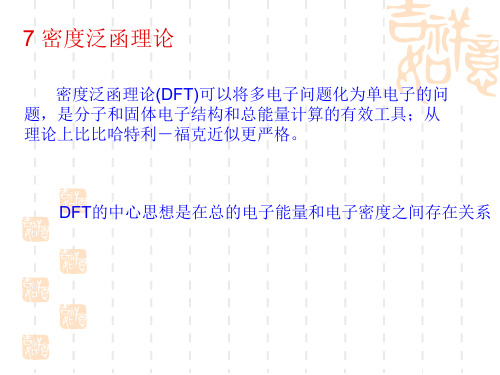
密度泛函理论(DFT)可以将多电子问题化为单电子的问 题,是分子和固体电子结构和总能量计算的有效工具;从 理论上比比哈特利-福克近似更严格。
DFT的中心思想是在总的电子能量和电子密度之间存在关系
7.1 Hohenberg-Kohn定理
定理1:系统的能量E是粒子密度(r)的唯一函数
Q[ f (r )] f (r )dr
f(r)常依赖于其他的函数;DFT理论下,函数依赖于电子密度 在简单的情况下,f(r)等于密度 ;在特殊情况下,f(r)依赖于(r)的梯度 (非局域性、梯度修正 ) 粒子数密度函数 是一个决定系统基态物理性质的基本参量。
定理2:在粒子数不变的条件下能量对密度函数变分得到系统基态的能量
交换和关联作用 (1)Gunnarsson以及Lundqvist
XC ( (r ))
r 0.458 ( s ) rs 0.0666 G 11.4
1 x 1 3 3 1 2 G( x) (1 x) log(1 x ) x , rs 2 2 3 4 (r )
E[ ( r )] Vext ( r )dr F[ ( r )]
第一项是由电子和外加势场的作用引起的。
F[(r)]为电子动能项和电子间相互作用的综合。
能量的极小值对应精确的基态电子密度。因此可以使用变分方法。
条件限制,即电子的总数N是固定的 引入Lagrangin因子(-),
7.4 交换关联函数
局域密度近似(LDA): •基于均匀电子气的模型, •基本假设为电子密度在局部空间是均匀的
E XC [ (r )] (r ) xc ( (r )) d
XC((r))是在均匀电子气条件下每个电子的交换-关联能密度 交换关联势通过对上式进行微分得到。
第一性原理- DFT理论ppt课件
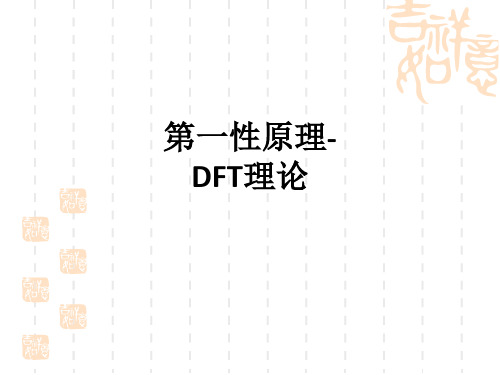
d ( ( r )) xc V [ r ] ( r ) ( ( r )) X C X C d ( r )
XC((r))是在均匀电子气条件下等于VXC
基本物理意义:局域密度近似中假设在非均匀电子分布下,在位置r处(电子 密度为(r))的VXC与XC((r))和在均匀电子气模型下具有相同的值 ,或者说,围绕
某一体积元素的位于位置r处真实的电子密度被一个位于r的常电子密度所代替
经常把XC((r))表达为电子密度的解析函数
交换和关联作用 (1)Gunnarsson以及Lundqvist
( ( r )) XC
0 . 458r (s) r 0 . 0666 G 11 . 4 s
1 1 3 1 2 x 3 G ( x ) ( 1 x ) log( 1 x ) x , r s 2 2 3 ( r ) 4
7.2 Kohn-sham方程
Kohn和sham提出具体求解Hohnberg_Kohn方程的方法 Kohn和sham假设:
F [ ( r )] E [ ( r )] E [ ( r )] E [ ( r )] KE H XC
第一项为动能;第二项为库仑作用能;第三项为电子的交换关联能。
2 E [ ( r )] ( r )( ) ( r ) d KE i i 2 i 1 N
条件限制,即电子的总数N是固定的 引入Lagrangin因子(-),
N ( r ) dr
[ E [ ( r )] ( r ) dr ] 0 [ ( r )]
E [(r)] (r) Ve x t
上式是薛定额方程的DF关联函数
局域密度近似(LDA): •基于均匀电子气的模型, •基本假设为电子密度在局部空间是均匀的
第一性原理计算ppt课件
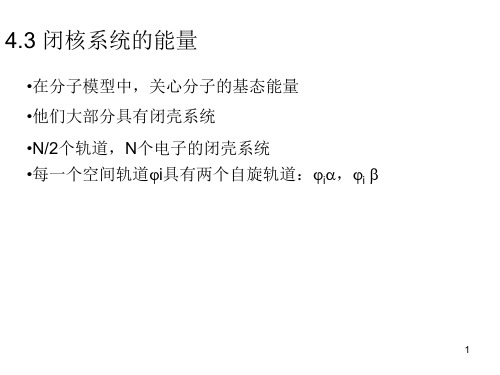
N /2
2
H
c ii
ore
i 1
2
• 电子与电子的作用项
• i和j中存在4个电子。
• 在一个轨道上的2个电子以库仑作用的方式与另一个轨道 上的两个电子发生作用。记为4Jij。
• 但是在这些组合中,包含了成对电子的两种作用方式,给 出了总的交换能-Kij。
• 最后,在同一轨道上的一对电子库仑作用也要考虑在内, 但是这些电子具有成对的自旋因此不存在交换能。
i1
i1i1
N/2
Fi(1)H co(r1)e 2Jj(1)Kj(1)
j1
引入了轨道i的原子轨道展开形式,把相应的i轨道带入H-1)i cv1v(1)
v1
v1
20
每一侧都乘以u(1),(也是一基函数),积分
K
K
c vid1(1 )F i(1 )v(1 )i c vid1(1 )v(1 )
屏蔽常数按下列规则确定 :
把轨道划分如下组: (1s);(2s,2p);(3s,3p);(3d);(4s,4p);(4f);(5s,5p);(5d)
14
对给定的轨道,屏蔽常数有下列贡献之和确定 • 如果到原子核的距离比到上述各组远,取0; • 同一组的其他电子贡献为0.35;但若其他轨道为1s,则贡献为0.3。 • 电子的主量子数比现有轨道小2或更多,则贡献为1。 • 如果每一个电子具有的主量子数比现有轨道小1:现有轨道为d或f,取
5
• 这一条件作用于能量表达式 ,得到Hartree-Fock方程
• 正交归一化条件可以写为交叠矩阵Sij
Sijijdij
• 能量最小的限制条件可以通过Lagrange因子解决 • 最小化的函数的微分加上限制条件乘以Lagrange乘法因子
第一性原理ppt课件

找到第一性原理也就找到了钥匙
宇宙的
终极钥匙
万有引力 相对论
量子力学
统一场论
那么,我们如何发现第一性原理?
THANKS
THANK
YOU
SUCCESS
2019/5/8
认知升级之第一性原理
李善友@混沌大学2017年6月
模型1
刻意练习
1 创建模型
2 刻意练习
3 及时反馈
我们脑子里的思维模型很多
我们怎么知道哪些是好的,哪些是坏的?
模型2
第一性原理
第一性原理
一种建立可信赖逻辑模型的思维模型
两种逻辑
两种逻辑形式使用比例
所以:在我们的经验里,未来总是和过去一样的
可见:“连续性假设”本身也来自于归纳法
通过归纳法得出的结论 归纳法成立的前提,必须建立在,并不存在的“连续性假设”之上
“连续性假设”,很有可能导致灾难 那么,人类为什么依然依赖这个“非逻辑性的武断”?
最小作用原理 为了节省大脑的运算空间,人类只能假设未来不会变
But...演绎法也有一个结构性问题 他的前提如果来自归纳法,则同样终极无效
所有的人都会死 苏格拉底是人
所以苏格拉底也会死
But...凭什么说“所有人都会死”呢?
归纳法的问题是:对最近的偶然现象过度重现,以至自圆其说 演绎法的问题是:你凭什么相信的道理必然为真
如何保证演绎法的前提必须是真是的
归纳法-99%
演绎法-1%
从归纳法,到演绎法
所需计算功率更高,所消耗认知能量更高
1、归纳法
归纳法是人类最基础、最常见的用智方式
借助感觉和经验来积累知识
归纳法
一、空间性归纳法
二.时间性归纳法
DFT ppt课件
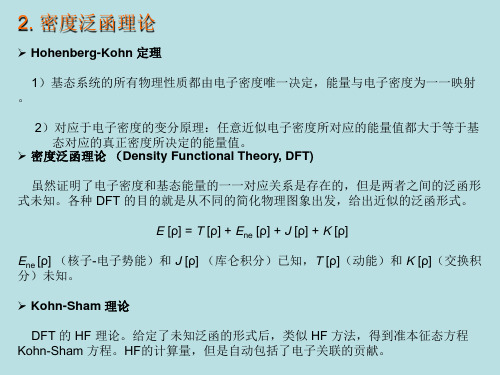
3. 第一性计算的应用举例
3.1. 数量分析(Population Analysis)
➢ 确定每个原子上有效的电子数目(一般不是整数)。一个重要的应用是给定每个 原子上的部分电荷(partial charge),作为全原子模拟时经验力场的一部分。
➢ 基于原子轨道(基矢)的分析: Mulliken Population Analysis: 正交不归一的基矢。 Löwdin Population Analysis: 正交归一的基矢。
f14/314/32 221/31
x r S X x x 2 b x c Q 4 c b 2
GGA (见下)中的 PW91 修改了 VWN 的泛函形式
:c P /W a 9 1 x 2 a1 x 2ln 1 2 a1 x 2 x 2 1 3 x 3 4 x 4
➢ 方法:一般的做法是根据原子间相互作用的物理特性,预先设定一个有待定参数的 二体或多体的相互作用的经验势的函数形式,然后根据第一性计算的数据或 实验结果拟合经验势的参数。
➢ 误差:因为描述体系的自由度被大大减少,全原子模型不可能重建系统的所有性 质。拟合参数时,往往选择一组最关心的物理性质进行拟合,以求误差尽 量小,而放松对其它性质的要求。所以要根据待研究的物理问题适当选取 全原子模型。
➢ 过渡态理论(Tranistion State Theory, TST):假设沿反应坐标的所有点都处 在热力学平衡态,因而系统处在某一状态的几率服从玻尔兹曼分布。
➢ 反应势能面(Potential Energy Surface, PES):除反应坐标之外的其它自由 度上系统都处在最低能量态。
➢ 鞍点(Saddle Point):即 TS,沿反应坐标的极大值点
关联项
第一性原理 DFT理论
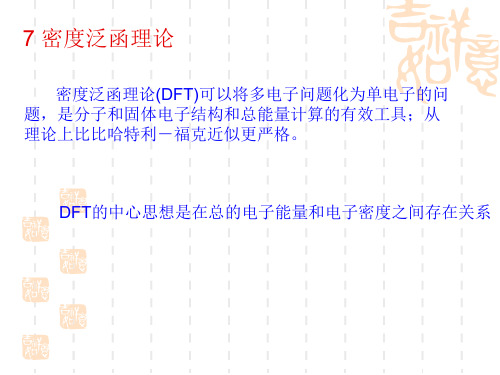
Ve
xt
上式是薛定额方程的DFT等效式
7.2 Kohn-sham方程
Kohn和sham提出具体求解Hohnberg_Kohn方程的方法
Kohn和sham假设:
F[(r)] EKE [(r)] EH [(r)] EXC [(r)]
第一项为动能;第二项为库仑作用能;第三项为电子的交换关联能。
N
EKE [ (r)]
i 1
i
(r
)(
2 2
)
i
(r
)d
第二项为hartree静电能
其他没有考虑 的能量项考虑 在内。
EH
[ (r )]
1 2
(r1) (r
r1 r2
2)dr1dr2
考虑电子与原子核的相互作用
N
E [(r)]
i 1i (r)( Nhomakorabea2 2)i (r)d
1 2
(r1)(r2) r1 r2 dr1dr2
7.5 Kohn-Sham方程的解法
K-S轨道表示为已原子为中心的基函数的线性组合
K
i (r) cviv 1
几种函数形式用于基函数 (1)高斯函数;(2)Slater函数;(3)数值基函数
K-S轨道的扩展轨道形式带入K-S方程 式中,可以得到一个矩阵形式
HC=SCE
H
d1 (r1)
7 密度泛函理论
密度泛函理论(DFT)可以将多电子问题化为单电子的问 题,是分子和固体电子结构和总能量计算的有效工具;从 理论上比比哈特利-福克近似更严格。
DFT的中心思想是在总的电子能量和电子密度之间存在关系
7.1 Hohenberg-Kohn定理
定理1:系统的能量E是粒子密度(r)的唯一函数
第一性原理及密度泛函理论
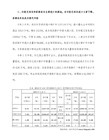
引
的理论。
言
l 量力力学是反映微观粒子(分子、原子、原子核、基本粒子)运动规律
Байду номын сангаас
l 以量子力学为基础,结合高速发展的计算技术分别建立起来的计算材 料科学、计算物理、量子化学等分枝学科,促进了物理学、化学和材 料科学的发展,为发展和设计新型材料提供了理论基础和新的研究方 法。 l 在理论上最具诱惑力,且在将来最有可能开展真正意义上的材料设计 的计算就是解体系的Schrődinger方程,即为计算材料学中的第一原理 计算。
密度泛函理论
• 在密度泛函理论中,将电子密度作为描述体系状态的基本变量,可追 溯到Thomas和Fermi用简并的非均匀电子气来描述单个原子的多电子 结构。
• 直到Hohenberg和Kohn提出了两个基本定理才奠定了密度泛函理论的 基石。 • 随后Kohn和Sham的工作使密度泛函理论成为实际可行的理论方法。
多粒子体系的第一原理
• 第一原理的基本思想:
将多原子构成的体系理解为由电子和原子核组成的多粒子系统,在 解体系Schrődinger方程的过程中,最大限度地进行“非经验性”处理, 即不涉及任何经验参数,所要输入的只是原子的核电荷数和一些模拟环 境参量。 计算所求得的结果是体系Schrődinger方程的本征值和本征函数(波 函数),有了这两项结果,就可研究体系的基本物理性质。
多粒子体系的第一原理
l 价电子近似
在原子模型中,近核电子可被紧紧束缚在核的周围,这些束缚电子 是定域的,比较稳定,因而对固体性质的贡献很小。而在外层轨道的 价电子可以是离域的,当原子结合在一起组成固体时,这些电子的状 态变化很大,对固体的电学和光学性质有决定性的影响。因此,可将 固体看作是由原子核-束缚电子构成的离子核和价电子组合而成。
第一性原理与密度泛函理论PPT课件

4
• 多粒子系统的Schrődinger方程
其中ψ 和H分别对应于多粒子系统的波函数和哈密顿量。
原则上只要对上式进行求解即可得出所有物理性质,然而由于电子之间的相 互作用的复杂性,要严格求出多电子体系的Schrődinger方程解是不可能的, 必须在物理模型上进一步作一系列的近似。
5
+ 换句话说,做第一原理计算(ab initio calculation)便可知道一块固体
猜测试探波函数 构造所有算符 求解单粒子赝薛定谔方程
对于解出的新的波函数,重新构造Hartree-Fock算符
重复以上循环,直到收敛(即前后叠代的结果相同)
自恰场(SCF)方法是求解材料电子结构问题的常用方法
11
对处理原子数较少的系统来说,Hartree-Fock近似是一种 很方便的近似方法。
决定的。
20世纪初量子力学的出现,原则上提出
了像原子核和电子这样的微观粒子运动
和交互作用的定律。
理论上,给定一块固体化学成分(即所 含原子核的电荷和质量),我们就可以 计算这些固体的性质。因为一块固体实 际上是一个多粒子体系。决定这个体系 性质的波函数可以通过解薛定谔 (Schrödinger)波动方程来获得。
的性质。
可 是 , 这 个 薛 定 谔 波 动 方 程 有 3×N 个 变 量
(N是粒子总数),极其复杂,假使我们把
目前世界上的所有电脑都用上,让它跑千年、
万年都不可能算出来。正如1929年量子物理
大师狄拉克(Dirac)所言:处理大部分物理
学和全部化学问题的基本定理已经完全知道。
困难在於这些定律的应用所引出的数学方程
动能可以写为
25Leabharlann 库仑能可具体表达为:此时总能量 Et的表达式可写为
DFT理论
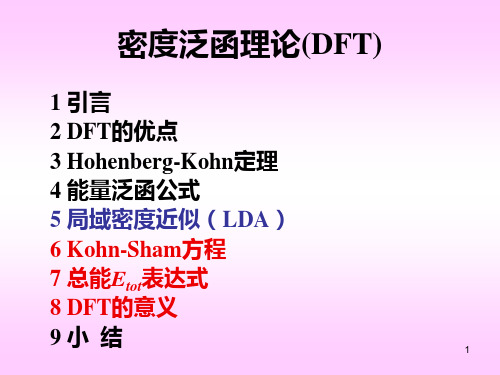
同时,把带撇的与不带撇的交换得
E E [v( r ) v ( r )]n( r )dr
(4.10)
或者
E E [v ( r ) v( r )]n( r )dr
(4.11)
可见(4.10)与(4.11)相互矛盾。表明v’(r) 不可能产生同样的n(r) . 所以v(r) 是n(r) 的唯一泛函。由于v(r) 决定整个H, 即系统的基态 能量是n(r) 的唯一泛函。 同理,T和U也是n(r) 的唯一泛函。可定义: F [n(r )] (, (T U )) (4.12) 式(4.12)是一个普适函数,适于任何粒子系和任何外部势。于是 整个系统的基态能量泛函可写为:
(4.22)
上式考虑另一个电子密度n’(r)。然后求E[n’]对n’的变分 δE[n’] /δn’为最小。相当于改变n’(r) 使E[n’] E[n]。 先求Ts[n’]: 为写出Ts[n’],考虑v’(r) 为一个试验的单电子势。可由v’(r) 满 足的单粒子方程,解出n’(r) 。
1 2
2 v '(r ) i' (r ) i' i' (r )
2
2。地位和作用 • 近几年来,DFT同分子动力学方法相结合, 有许多新发展; • 在材料设计、合成、模拟计算和评价诸多方 面有明显的进展; • 已成为计算凝聚态物理、计算材料科学和计 算量子化学的重要基础和核心技术; • 在工业技术领域的应用开始令人关注。
3
2 DFT的优点
• 它提供了第一性原理或从头算的计算框架。 在这个框架下可以发展各式各样的能带计 算方法。 • 在凝聚态物理中,如: 材料电子结构和几何结构, 固体和液态金属中的相变等。 • 这些方法都可以发展成为用量子力学方法 计算力的, 精确的分子动力学方法。
LDA+U第一性原理方法PPT课件

• Simplified rotationally invariant LDA+U : PRB 57 (1998) 1505 (VASP4.6, LMTO)
Original LDA+U(HMF) : PRB 44 (1991) 943
)]
Self-interaction correction (SIC)
Perdew and Zunger, PRB23(1981)5048
EGSIC [n] EGLDA[n]
1 2i
d 3rd 3r' ni (r)ni(r ' ) | r r '|
i
Exc[ni ]
ViSIC
(r )
e pe
Eexp(H-) = -1.0552 Ry ESIC(H-) = -1.0515 Ry ELDA(H-) : no bound state
U = E(H+) + E(H-) -2E(H) = 0.9448 Ry
eLDA (H) = -0.538 Ry
U = 0.9448 Ry
Occupied (H) state: eLDA+U(H) = eLDA (H) -U/2 = -1.0104 Ry ~-1 Ry
e
Take Hydrogen for example:
p
Eexact(H) = -1.0 Ry
ELDA(H) = -0.957 Ry~ Eexact(H)
eLDA (H) = -0.538 Ry << Eexact (H)
- 1、下载文档前请自行甄别文档内容的完整性,平台不提供额外的编辑、内容补充、找答案等附加服务。
- 2、"仅部分预览"的文档,不可在线预览部分如存在完整性等问题,可反馈申请退款(可完整预览的文档不适用该条件!)。
- 3、如文档侵犯您的权益,请联系客服反馈,我们会尽快为您处理(人工客服工作时间:9:00-18:30)。
1
C ( (r)) 0.0480 0.0311inrpspt课件0.0116 rs 0.0020 rs ln rs ), rs 1 9
(4) 关联函数 Vosko,Wilk
C ((r))
A 2
ln
x2 X (x)
2b Q
tan 1
Q 2x b
i i (r1)
I为轨道能,VXC为交换关联势
电子关联势可以由能量关联能得到。
VXC
[r
]
EXC [(r)] [(r)]
ppt课件
6
7.3 自旋极化密度泛函理论
用来处理包含未成对电子的系统 自旋电子密度差异为净自旋密度
(r) (r) (r)
EH
[ (r )]
1 2
(r1) (r
r1 r2
2)dr1dr2
ppt课件
5
考虑电子与原子核的相互作用
N
E [(r)]
i 1
i (r)(
2 2
)i (r)d
1 2
(r1)(r2) r1 r2 dr1dr2
E
XC[(r)]
M A1
3
4 (r)
(2)交换能 Slater
E
X
[
(r
),
(r)]
3 2
(
3
4
)1/
3
( 3/ 4 (r) 3/ 4 (r))dr
(3)关联能 Perdew和Zunger
C ((r))
0.1423
/(1 1.9529
r1/ 2 s
0.3334
rs
),
ห้องสมุดไป่ตู้
rs
整个电子密度是上述两种类型的电子之和 这两种情况下电子的交换-关联能也是不同的
自旋极化Kohn-sham方程式
2 2
M
A1
ZA r!A
( r2
r12
)
d 2
VXC
(r1
)
i
( r1 )
i
i
( r1 )
ppt课件
7
7.4 交换关联函数
局域密度近似(LDA): •基于均匀电子气的模型, •基本假设为电子密度在局部空间是均匀的
E XC[(r)] (r) xc ((r))d
XC((r))是在均匀电子气条件下每个电子的交换-关联能密度 交换关联势通过对上式进行微分得到。
VXC [r]
(r)
d xc ( (r)) d (r )
Kohn和sham假设:
F[(r)] EKE [(r)] EH [(r)] EXC [(r)]
第一项为动能;第二项为库仑作用能;第三项为电子的交换关联能。
N
EKE [ (r)]
i 1
i
(r
)(
2 2
)
i
(r
)d
第二项为hartree静电能
其他没有考虑 的能量项考虑 在内。
ppt课件
8
经常把XC((r))表达为电子密度的解析函数
交换和关联作用
(1)Gunnarsson以及Lundqvist
XC ( (r))
rs
0.458 0.0666 G
( rs ) 11.4
G(x)
1 2
(1
x) log(1
x 1 )
x2
x 2
1 3
,
rs3
Q[ f (r)] f (r)dr
f(r)常依赖于其他的函数;DFT理论下,函数依赖于电子密度 在简单的情况下,f(r)等于密度 ;在特殊情况下,f(r)依赖于(r)的梯度 (非局域性、梯度修正 )
粒子数密度函数 是一个决定系统基态物理性质的基本参量。
ppt课件
2
定理2:在粒子数不变的条件下能量对密度函数变分得到系统基态的能量
XC
( (r ))
XC((r))是在均匀电子气条件下等于VXC
基本物理意义:局域密度近似中假设在非均匀电子分布下,在位置r处(电子
密度为(r))的VXC与XC((r))和在均匀电子气模型下具有相同的值 ,或者说,围绕 某一体积元素的位于位置r处真实的电子密度被一个位于r的常电子密度所代替
bx0 [ln X (x0 )
(x x0 )2 X (x)
2(b 2x0 ) X (x)
tan 1
Q 2x
b
]
x rs1/ 2 , X (x) x2 bx c,Q (4c b2 )1/ 2 , A 0.0621814, x0 0.409286, b 13.0720.c 42.7198
N (r)dr
[ ( r )]
[
E[
( r )]
(r)dr]
0
E[ (r )] (r)
Ve
xt
上式是薛定额方程的DFT等效式
ppt课件
4
7.2 Kohn-sham方程
Kohn和sham提出具体求解Hohnberg_Kohn方程的方法
7 密度泛函理论
密度泛函理论(DFT)可以将多电子问题化为单电子的问 题,是分子和固体电子结构和总能量计算的有效工具;从 理论上比比哈特利-福克近似更严格。
DFT的中心思想是在总的电子能量和电子密度之间存在关系
ppt课件
1
7.1 Hohenberg-Kohn定理
定理1:系统的能量E是粒子密度(r)的唯一函数
E[(r)] Vext(r)dr F[(r)]
第一项是由电子和外加势场的作用引起的。 F[(r)]为电子动能项和电子间相互作用的综合。 能量的极小值对应精确的基态电子密度。因此可以使用变分方法。
ppt课件
3
条件限制,即电子的总数N是固定的 引入Lagrangin因子(-),
ppt课件
10
ppt课件
11
7.5 Kohn-Sham方程的解法
K-S轨道表示为已原子为中心的基函数的线性组合
K
i (r) cviv 1
几种函数形式用于基函数 (1)高斯函数;(2)Slater函数;(3)数值基函数
K-S轨道的扩展轨道形式带入K-S方程 式中,可以得到一个矩阵形式
ZA (r)dr r RA
电子密度看作是一套单个电子正交归一的轨道的模的平方
N
(r) i (r) 2 i 1
通过变分方法,得到如下的单个电子的Kohn-sham方程式
12 2
M A1
ZA r!A
( r2
r12
)
dr2
VXC (r1) i (r1)
